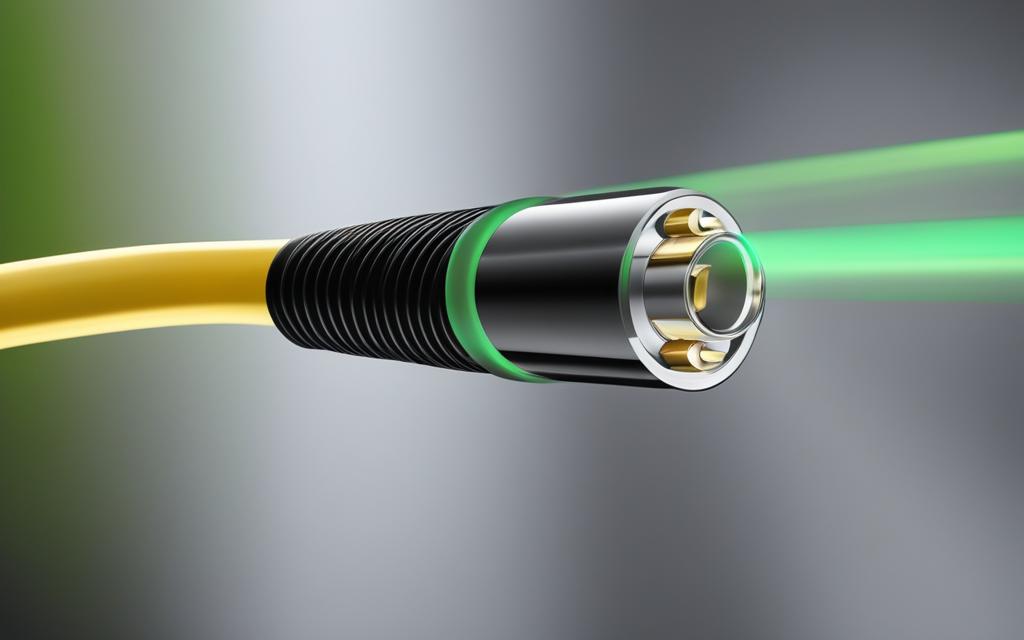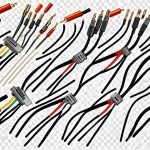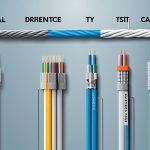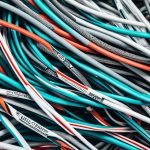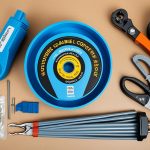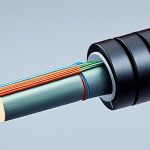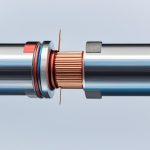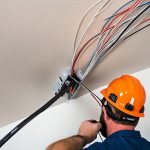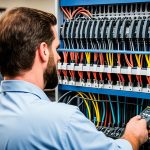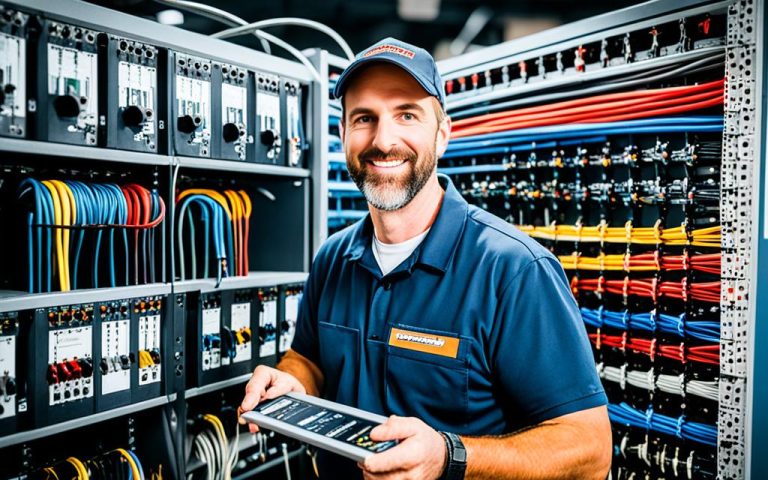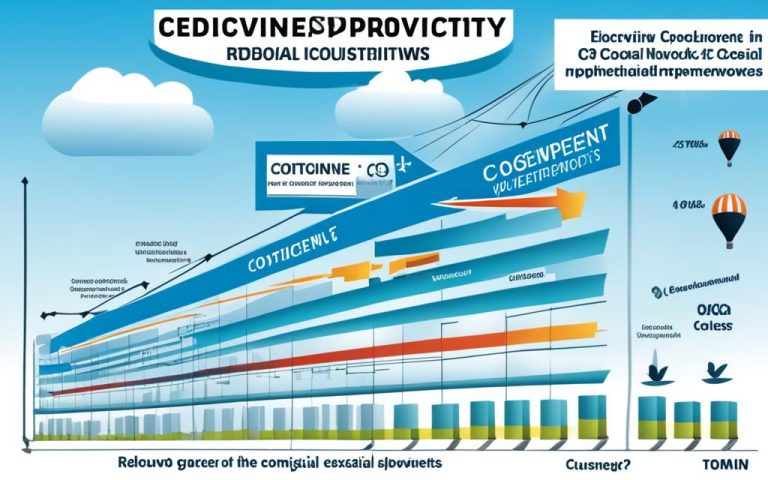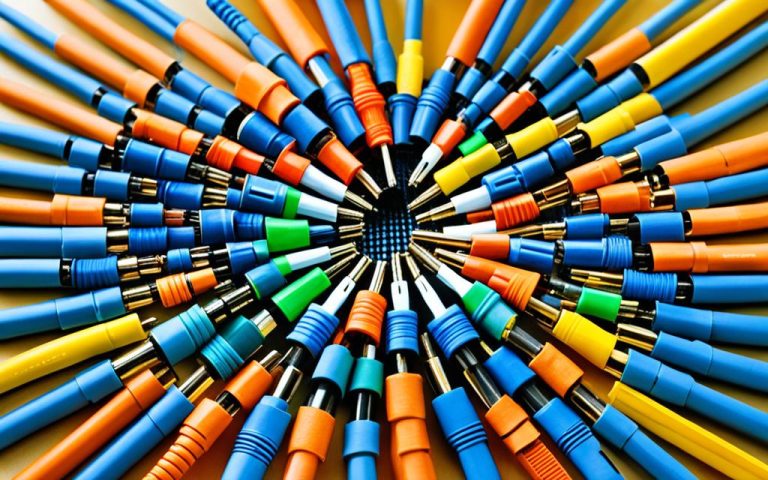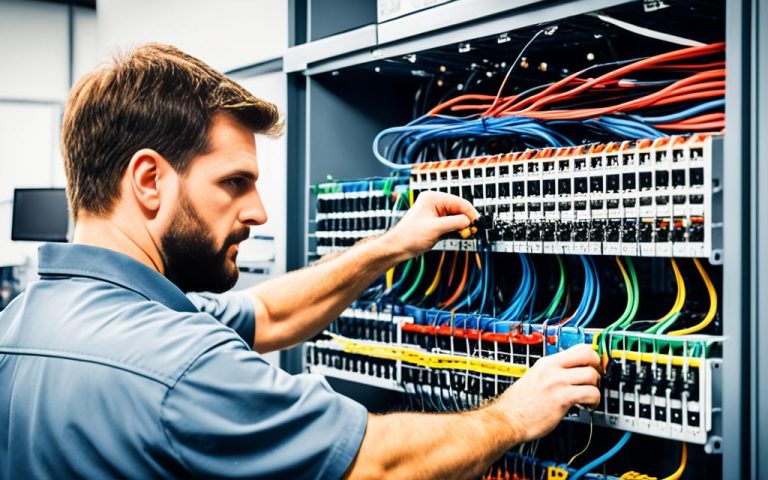When it comes to reliable data transmission and optimal network performance, signal integrity is of utmost importance in coaxial cable networks. As the demand for bandwidth increases and design complexity grows, engineers face the challenge of ensuring seamless connectivity and accurate data streams. From the Internet of Things to Industry 4.0 and interconnected ecosystems, constant streams of data are crucial for data-heavy applications.
While connector performance is often emphasized, it is just one piece of the puzzle. To achieve successful data transmission, factors such as cable quality, interface performance, and transmitter/receiver quality must be carefully considered. Parameters like attenuation, reflection, near-end crosstalk, and far-end crosstalk define balanced cabling performance, and every decision in the cable-connector assembly design can impact signal integrity.
To maintain reliable data transmission and network performance, engineers must overcome design challenges, improve impedance matching, minimize crosstalk, and optimize energy flow. Routing differential analog signals in coaxial cables involves careful considerations of frequency, impedance, and voltage standing wave ratio (VSWR) to minimize signal reflections. Additionally, selecting coaxial cables with suitable power handling capacity and low losses is crucial for efficient power transmission.
10 Key Design Challenges for High-Speed Data Transmission
High-speed data transmission poses various design challenges that engineers face in order to optimize products. These challenges arise due to factors such as signal degradation, impedance matching, and crosstalk. Let’s take a closer look at the 10 key design challenges:
- Loss of cable connection affecting signal transmission: The reliability of the cable connection plays a crucial role in maintaining high-speed data transmission. Any loss of connection can significantly impact signal integrity and overall performance.
- Signal degradation due to reflection and attenuation: Reflection and attenuation are major contributors to signal degradation in high-speed data transmission. Designing systems that can minimize these effects is essential.
- Impedance matching to optimize performance: Impedance matching is vital to ensure optimal performance in high-speed data transmission. Properly matching the impedance of connectors, cables, and devices helps maintain signal integrity.
- Minimizing crosstalk between parallel channels: Crosstalk, the unwanted coupling of signals between adjacent channels, can lead to interference and reduced performance. Minimizing crosstalk is essential for maintaining signal integrity in high-speed data transmission.
- Using a Vector Network Analyzer (VNA) to validate design performance: A VNA allows engineers to measure and analyze the performance of high-speed data transmission designs, helping identify any issues that may affect signal integrity.
- Geometrical optimization for improved energy flow: Optimizing the geometry of the transmission components can enhance the energy flow, reducing losses and improving signal integrity.
- Impedance measurement to ensure proper matching: Accurate impedance measurement is crucial to ensure proper impedance matching and maintain signal integrity in high-speed data transmission.
- De-embedding to remove the effects of PCB fixtures: PCB fixtures can introduce impedance mismatches and affect signal integrity. De-embedding techniques help eliminate these effects and ensure accurate performance measurements.
- Using SerDes simulation to measure data transmission rates: SerDes simulation allows engineers to evaluate the data transmission rates of high-speed systems, ensuring they meet the desired performance requirements.
- Link optimization to improve the channel eye diagram: Optimizing the link between transmitter and receiver can improve the channel eye diagram, increasing the signal integrity of high-speed data transmission systems.
Addressing these design challenges is essential for engineers to achieve high signal integrity and optimize the performance of high-speed data transmission systems.
Routing Differential Analog Signals in Coaxial Cables
Routing differential analog signals in coaxial cables requires careful consideration of factors such as frequency, impedance, and Voltage Standing Wave Ratio (VSWR). By splitting a differential pair into two sections, each connected to its own coaxial cable, engineers can ensure impedance matching and minimize signal reflections.
Impedance mismatches can lead to reflections at the input of the connectors, resulting in power loss, reduced efficiency, and potential equipment damage. To enforce impedance matching and reduce noise emission/reception, it is essential to design the traces in the pair with higher spacing and closer ground planes.
Choosing coaxial cables with low VSWR is crucial for maintaining signal integrity and efficient power transmission in high-power applications. Low VSWR values indicate good impedance matching, minimizing signal reflections and ensuring optimal power transmission.
To summarize:
Routing differential analog signals in coaxial cables involves:
- Splitting the differential pair into two sections, each connected to its own coaxial cable
- Designing traces with higher spacing and closer ground planes for impedance matching
- Choosing coaxial cables with low VSWR to minimize signal reflections
By following these guidelines, engineers can optimize signal integrity and ensure reliable power transmission in high-power applications.
Power Handling Capacity and Losses in Coaxial Cables
In high-power applications, selecting coaxial cables with sufficient power handling capacity is crucial to prevent signal degradation and cable damage. Factors such as cable size, conductor material, and dielectric properties influence the power handling capacity.
Minimizing power losses and attenuation is essential for efficient power transmission, as lower insertion losses and attenuation enable more power to reach the intended destination. By choosing coaxial cables with low losses and attenuation, engineers can optimize power transmission and maximize system performance.
| Factor | Influence on Power Handling Capacity |
|---|---|
| Cable Size | A larger cable size allows for higher power handling capacity. |
| Conductor Material | Cables with conductors made of materials with high conductivity have higher power handling capacity. |
| Dielectric Properties | Coaxial cables with low dielectric losses have higher power handling capacity. |
Efficient power transmission requires minimizing losses and attenuation. Lower insertion losses and attenuation result in more power reaching the intended destination, ensuring optimal system performance.
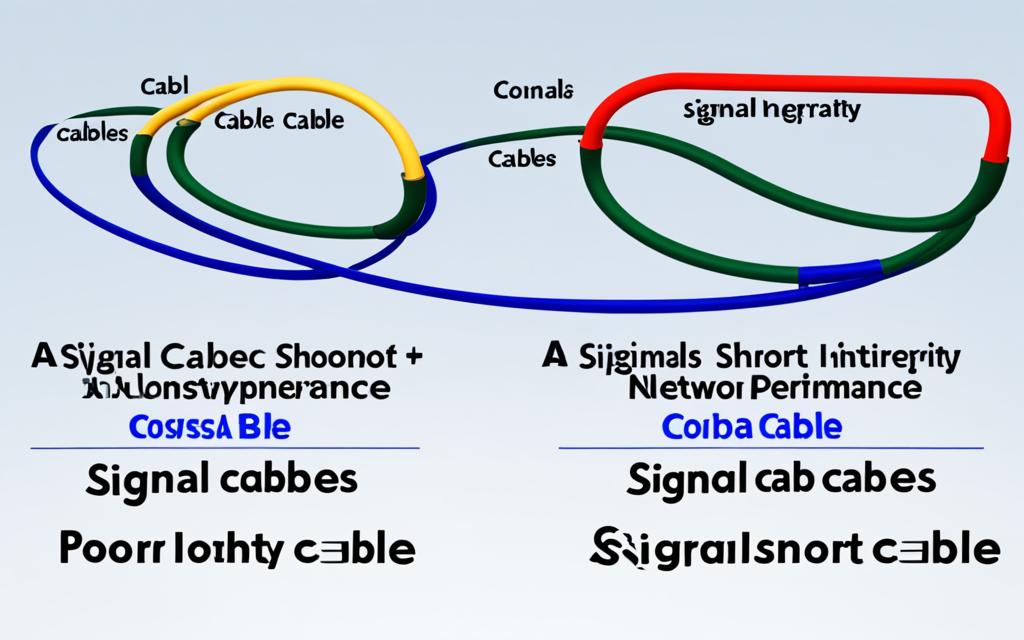
By carefully considering the power handling capacity of coaxial cables and minimizing losses and attenuation, engineers can achieve efficient power transmission in high-power applications.
Voltage Standing Wave Ratio (VSWR) and its Impact on Signal Integrity
In the realm of coaxial cable networks, the voltage standing wave ratio (VSWR) plays a crucial role in determining signal integrity. VSWR is a metric used to measure the efficiency of power transmission along a coaxial cable and quantifies the extent of signal reflections caused by impedance mismatches.
A low VSWR is essential in minimizing signal reflections, as high levels of reflection can lead to power loss, reduced efficiency, and potential equipment damage. When there is poor impedance matching, indicated by high VSWR values, the result is decreased signal integrity.
Choosing coaxial cables with a low VSWR is of utmost importance as it helps maintain optimal signal integrity and ensures efficient power transmission in high-power applications. By selecting cables with low VSWR, engineers can effectively minimize signal reflections and maintain robust network performance.
To visualize the impact of VSWR on signal integrity, consider the following example:
When using a coaxial cable with a high VSWR, the reflected signal can interfere with the original signal, leading to power loss and a decrease in the quality of the transmitted data. Conversely, a coaxial cable with a low VSWR enables efficient power transmission and reliable data transmission, ensuring signal integrity.
A high-performance coaxial cable with low VSWR is an essential component in preserving signal integrity and achieving reliable data transmission in high-power applications.
| VSWR Value | Signal Integrity |
|---|---|
| Low (Close to 1) | Optimal signal integrity |
| High (Greater than 2) | Decreased signal integrity |
MegaPhase’s Coaxial Cable Solutions for High-Power Applications
MegaPhase offers a comprehensive range of coaxial cable solutions designed specifically for high-power applications. Their cables, such as the GrooveTube® and Phase3 Products, are engineered to handle demanding power levels while offering low VSWR and exceptional performance.
These cables are trusted in industrial and defense applications, such as radar systems and satellite communication, where reliable power transmission and signal integrity are crucial. MegaPhase’s cables are also suitable for space applications, providing robust performance in extreme environments. Their Phase3 and AlumiBend cables have been used in space missions, ensuring reliable communication, data transmission, and power distribution in satellites and space probes.
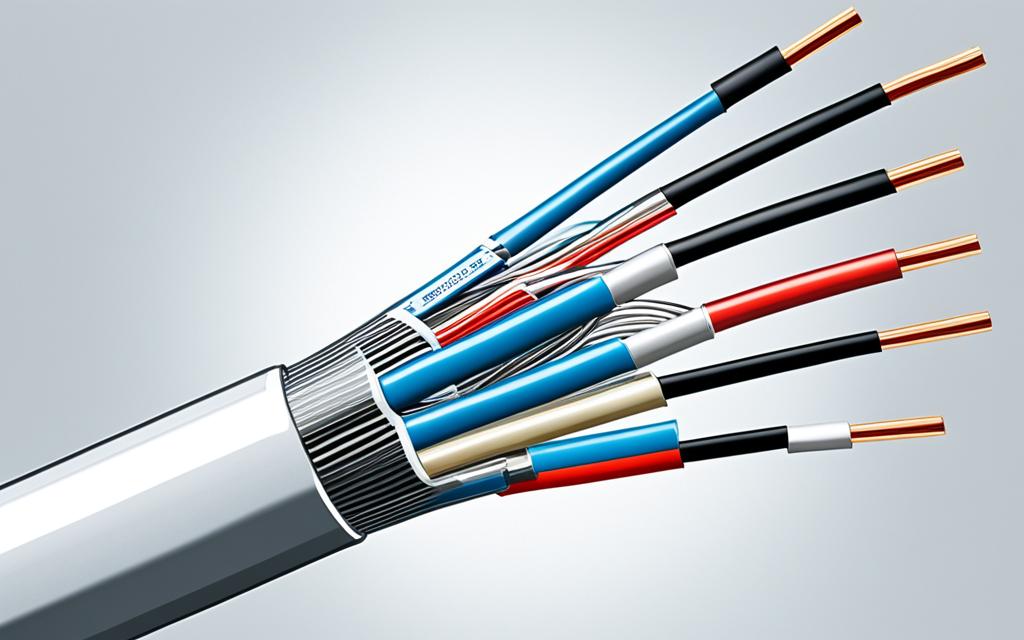
| Coaxial Cable Type | Power Handling Capacity | VSWR | Signal Integrity |
|---|---|---|---|
| GrooveTube® | High | Low | Exceptional |
| Phase3 Products | High | Low | Exceptional |
| AlumiBend | High | Low | Exceptional |
MegaPhase’s coaxial cable solutions provide engineers with the confidence they need to ensure efficient power transmission and maintain optimal signal integrity in high-power applications.
Considerations for Selecting Coaxial Cables in High-Power Applications
When it comes to high-power applications, selecting the right coaxial cables is crucial. There are several key considerations that engineers must take into account to ensure optimal performance, power transmission, and signal integrity. By carefully evaluating power handling capacity, losses and attenuation, Voltage Standing Wave Ratio (VSWR), and signal integrity, engineers can make informed decisions that will impact the overall efficiency and reliability of their systems.
Power Handling Capacity
Power handling capacity refers to the ability of coaxial cables to handle high levels of power without experiencing signal degradation or cable damage. It is influenced by factors such as the size of the cable, conductor material, and dielectric properties. Selecting coaxial cables with sufficient power handling capacity is essential to prevent power loss and ensure efficient power transmission.
Losses and Attenuation
Efficient power transmission requires minimizing power losses and attenuation in coaxial cables. Lower insertion losses and attenuation result in more power reaching the intended destination, maximizing system performance. Choosing coaxial cables with low losses and attenuation is crucial for optimizing power transmission in high-power applications.
Voltage Standing Wave Ratio (VSWR)
VSWR measures the efficiency of power transmission along a coaxial cable and identifies the extent of signal reflections caused by impedance mismatches. High VSWR values indicate poor impedance matching and can result in decreased signal integrity. Maintaining a low VSWR is essential to prevent power loss and ensure optimal signal integrity in high-power applications.
Signal Integrity
Signal integrity is a critical factor in high-power applications and relies on selecting coaxial cables that can maintain the integrity of the transmitted signals. By minimizing losses, attenuation, and signal reflections, engineers can ensure reliable data transmission, prevent power loss, and protect equipment from potential damage.
It is worth noting that MegaPhase offers a comprehensive range of coaxial cable solutions designed specifically for high-power applications. Their cables are engineered to meet the demands of high-power environments, providing reliable power transmission, low VSWR, and exceptional signal integrity. Whether it’s industrial and defense applications or space missions, MegaPhase’s coaxial cable solutions deliver optimal performance and reliability.
When selecting coaxial cables for high-power applications, it is essential to consider power handling capacity, losses and attenuation, VSWR, and signal integrity. By choosing the right cables, engineers can ensure efficient power transmission, minimize signal degradation, and maintain optimal system performance. MegaPhase’s coaxial cable solutions offer a reliable choice for high-power applications, delivering the performance and quality necessary for demanding environments.
Conclusion
Signal integrity plays a crucial role in ensuring reliable data transmission and optimizing network performance in high-power applications. Engineers face various design challenges, such as signal degradation, impedance matching, and crosstalk, when striving for high-speed data transmission. By overcoming these challenges, engineers can enhance the performance of their products and achieve seamless connectivity.
Proper routing of differential analog signals in coaxial cables is vital for maintaining signal integrity and minimizing signal reflections. Careful consideration of factors such as frequency, impedance, and voltage standing wave ratio (VSWR) allows engineers to optimize the performance of coaxial cable networks.
When selecting coaxial cables for high-power applications, it is essential to consider factors such as power handling capacity, losses, and VSWR. Coaxial cables with sufficient power handling capacity, low losses, and low VSWR are crucial for efficient power transmission and optimal performance. MegaPhase, a trusted brand in the industry, offers a comprehensive range of coaxial cable solutions designed specifically to address the needs of high-power applications. Their cables provide reliable power transmission and excellent signal integrity, making them the ideal choice for demanding industrial, defense, and space applications.
In conclusion, engineers must prioritize signal integrity in coaxial cable networks to achieve reliable data transmission and superior network performance in high-power applications. By addressing design challenges, implementing proper routing techniques, and selecting the right coaxial cables, engineers can optimize power transmission while ensuring robust signal integrity. MegaPhase’s expertise and comprehensive range of coaxial cable solutions make them a trusted partner for high-power applications, providing reliable performance and peace of mind.
FAQ
What is signal integrity and why is it important in coaxial cable networks?
Signal integrity refers to the quality of a signal as it is transmitted from one point to another. In coaxial cable networks, signal integrity is crucial for reliable data transmission and optimal network performance. Poor signal integrity can result in signal degradation, power loss, and reduced efficiency, leading to potential damage to equipment and compromised network functionality.
What are the key design challenges for high-speed data transmission?
The key design challenges for high-speed data transmission include addressing signal degradation, impedance matching, and minimizing crosstalk. Engineers must ensure that the cable connections do not affect signal transmission, minimize signal reflections and attenuation, optimize impedance matching, and reduce interference between parallel channels. Additionally, using tools like a Vector Network Analyzer (VNA) and optimizing the channel eye diagram are important steps in achieving successful high-speed data transmission.
How can engineers ensure proper routing of differential analog signals in coaxial cables?
To ensure proper routing of differential analog signals in coaxial cables, engineers must consider factors such as frequency, impedance, and Voltage Standing Wave Ratio (VSWR). By splitting a differential pair into two sections, each connected to its own coaxial cable, impedance matching can be achieved, minimizing signal reflections. Designing traces with higher spacing and closer ground planes helps enforce impedance matching and reduce noise emission/reception.
What is the importance of power handling capacity and losses in coaxial cables?
Power handling capacity and losses are crucial considerations for coaxial cables in high-power applications. Selecting cables with sufficient power handling capacity ensures that the cables can handle the power levels required without degrading the signal. Minimizing power losses and attenuation is important for efficient power transmission, as lower insertion losses and attenuation enable more power to reach the intended destination.
What is Voltage Standing Wave Ratio (VSWR) and how does it impact signal integrity?
Voltage Standing Wave Ratio (VSWR) is a measurement of how efficiently power is transmitted along a coaxial cable, indicating the extent of reflections caused by impedance mismatches. High VSWR values indicate poor impedance matching, resulting in decreased signal integrity, power loss, reduced efficiency, and potential damage to equipment. Choosing coaxial cables with low VSWR helps maintain optimal signal integrity and ensures efficient power transmission in high-power applications.
What coaxial cable solutions does MegaPhase offer for high-power applications?
MegaPhase offers a comprehensive range of coaxial cable solutions specifically designed for high-power applications. Their cables, such as the GrooveTube® and Phase3 Products, are engineered to handle demanding power levels while providing low VSWR and exceptional performance. These cables are trusted in industrial and defense applications, including radar systems and satellite communication, where reliable power transmission and signal integrity are crucial. MegaPhase’s cables are also suitable for space applications, offering robust performance in extreme environments.
What considerations should be taken into account when selecting coaxial cables for high-power applications?
When selecting coaxial cables for high-power applications, it is important to consider factors such as power handling capacity, losses, attenuation, VSWR, and signal integrity. Choosing cables with sufficient power handling capacity and low losses enables efficient power transmission and minimizes signal degradation. Low VSWR is crucial for maintaining signal integrity and preventing power loss. MegaPhase’s comprehensive range of coaxial cable solutions addresses these considerations, providing reliable power transmission and optimal performance in various high-power applications.
How important is signal integrity in coaxial cable networks for high-power applications and how can MegaPhase help?
Signal integrity is of utmost importance in coaxial cable networks for high-power applications. Poor signal integrity can lead to unreliable data transmission, decreased network performance, and potential damage to equipment. MegaPhase offers a range of coaxial cable solutions specifically designed for high-power applications, providing reliable power transmission and maintaining optimal signal integrity. Their cables have been trusted in various industries, including industrial, defense, and space applications, where signal integrity and power efficiency are critical.

